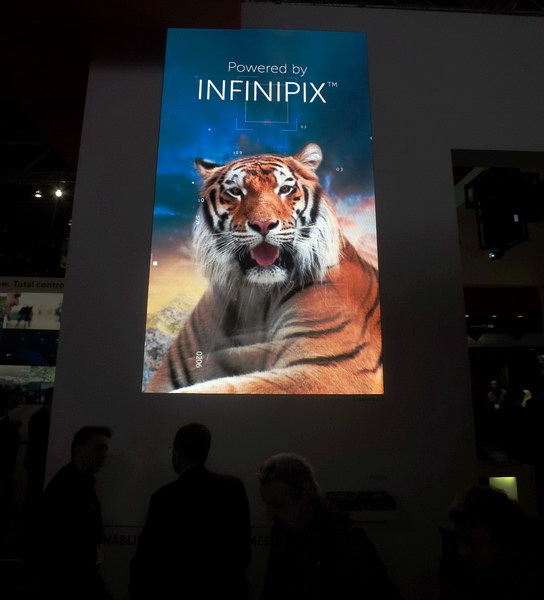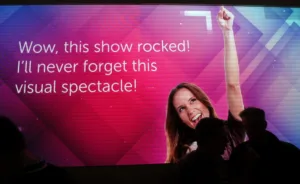Barco, as usual, had a large and busy booth at ISE. Again, as usual, they gave away a lot of good Belgian beer every afternoon after 5:00. I wish I’d had time to have one!
Barco Projectors
 Barco 6P laser projector running at 20% of its peak output on a dome screen. (Credit: M. Brennesholtz)
Barco 6P laser projector running at 20% of its peak output on a dome screen. (Credit: M. Brennesholtz)
The centerpiece of the booth, for a projector guy at least, was their XDL 4K60 laser-illuminated projector. This wasn’t just a RGB projector, it was a 6P (6 primary) laser projector, capable of showing 6P 3D, although all the images I saw at ISE were 2D. The projector is capable of producing up to 75,000 lumens but at ISE, because of limited space, it was running at about 20% of its total light output, i.e. only 15,000 lumens. It was also showing on a dome screen, a notoriously poor way to highlight projectors, especially in terms of contrast and color. Oh, well, I was impressed anyway!
Barco also makes 30,000 and 60,000 lumen versions of this projector. I was told this projector had the same electronics used in all its event projectors and the same software so it won’t be that different from a regular Barco rental and staging projector for technicians setting it up. Except for performance, that is. The optical engine comes from a Barco 6P laser cinema system but this version does not have the DCI electronics.
 Barco used a pair of edge-blended UDX-4K32 projectors to make a single large image on an ISE walkway. The projectors used 0.4:1 throw ratio lenses with 100% vertical offset. (Credit: M. Brennesholtz)
Barco used a pair of edge-blended UDX-4K32 projectors to make a single large image on an ISE walkway. The projectors used 0.4:1 throw ratio lenses with 100% vertical offset. (Credit: M. Brennesholtz)
The Barco 3-chip DLP UDX-4K32 and its companion the UDX-4K22 were actually introduced in mid-2017 and have been discussed in Large Display Monitor several times, including by me after the Rental and Staging Roadshow. The projectors are actually UHD (3840 x 2160), not true 4K, and achieve their UHD resolution from the 0.9” DLP imager with a native resolution of 2,560 x 1,600 via pixel shift. According to the Barco rep, they have been very successful in the market. They use laser-phosphor illumination technology. Like the laser projector on the dome, the image was not flattered by the location in the booth, the screen used or the content chosen for display by Barco. Still, it represented an impressive pair of projectors.
Barco had a variety of other projectors around and over it’s booth including a single-chip DLP F-80 projector with another 0.4:1 short throw lens. These projectors were making a variety of images overhead.
Barco RP Cubes.
While Leyard and Christie have exited the RP cube market, Barco has not and there is no sign of them exiting it any time soon. I was told by Suchit Rout, Director, Global Strategic Marketing, Enterprise BU, that Barco had anticipated there would be a drop in the cube market due to competition with LCDs and LED videowalls. He said this did not occur. In fact, Barco is seeing a 2% – 3% per year growth in the RP cube market.
On the other hand, while they demonstrated a RP cube wall with their RGB laser-based ODL-721 cubes, which have been on the market for about two years, they did not introduce any new cubes. They did launch earlier in February a RP engine as a LED to RGB Laser video wall upgrade. This engine fits in Barco OL-7xx RP cubes. At least for now, they are not offering it as an upgrade for other brands of RP cubes. This RBG engine will produce screen brightness 2x that of the LED engine it replaces, with a 3x increase in energy efficiency, from 2.3 lumens per watt to 7.5 lumens per watt. Even if you use the engine to get the full 2x the brightness, there will still be a reduction in total system power.
X-Series LED Videowalls
Barco X-series videowall display at ISE. The left half is made of X1.5 modules and the right half is made of X1.2 modules. The image artifacts in the photo were not visible to the eye. (Credit: M. Brennesholtz)
Barco was demonstrating its X1.2 and X1.5 LED videowall modules as the right and left halves of a large videowall display respectively. These modules were announced last June but, as far as I can tell, have not previously been covered by Large Display Monitor.
The modules have 1.29mm and 1.58mm pitches, respectively. They both have 880 cd/m² of brightness and are for indoor use only with an IP30 rating. They use the Infinpix control system, which is said to maintain good image quality, day or night.
“Thanks to Infinipix, image quality is perfect in both dimmed and high-brightness mode and it stays constant over time. What’s more, the X1.2 and the X1.5 guarantees accurate colors at all times. And no image tearing or video hiccups occur as video is smoothly synchronized.”
 The videowall with X2.5 modules was high overhead and the pixel pitch of 2.5mm was not noticeable. (Credit: M. Brennesholtz)
The videowall with X2.5 modules was high overhead and the pixel pitch of 2.5mm was not noticeable. (Credit: M. Brennesholtz)
Barco also showed a videowall using the X2.5 modules at ISE. These modules have a pixel pitch or 2.5mm and a brightness of 1,300 cd/m² (calibrated). The fourth member of the family, the X4 with a 4mm pixel pitch was not shown.
UniSee Still Impresses
 4 x 4 array of Barco UniSee panels at ISE. (Credit: M. Brennesholtz)
4 x 4 array of Barco UniSee panels at ISE. (Credit: M. Brennesholtz)
Barco was also showing a large, 4 x 4 array of their UniSee tiled LCD panels. Since I covered UniSee thoroughly when it was first introduced and there were no new developments shown at ISE, I won’t go into more detail. –Matthew Brennesholtz
Analyst Comment
This was my first chance to see the UniSee LCDs ‘in the flesh’ and I was as impressed as Matt was at the launch by the quality of the uniformity achieved. I also found out (not from Barco) that the panels come from Innolux in Taiwan. Barco buys open cells from the firm and adds its own backlights and supporting hardware. (BR)

